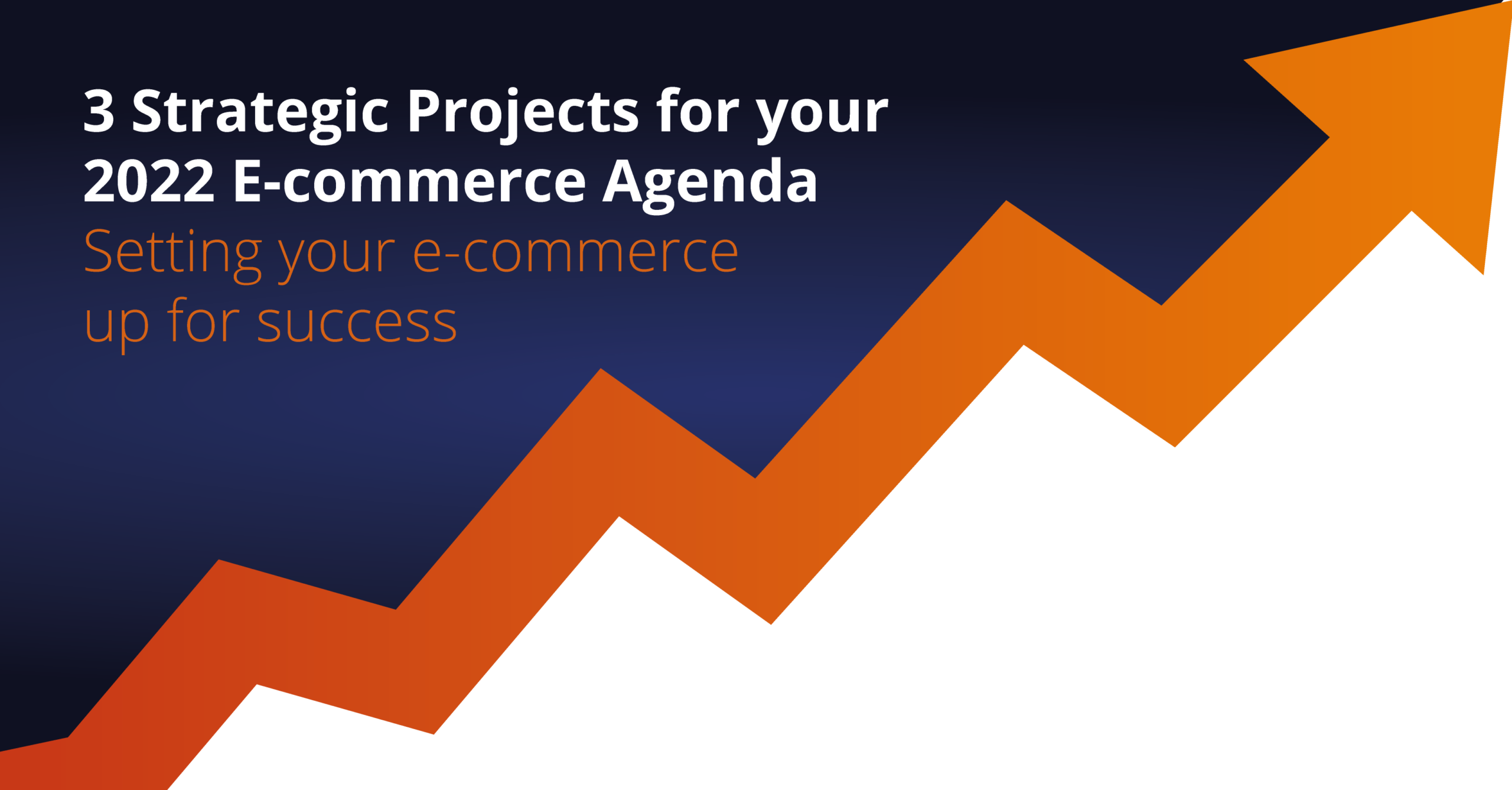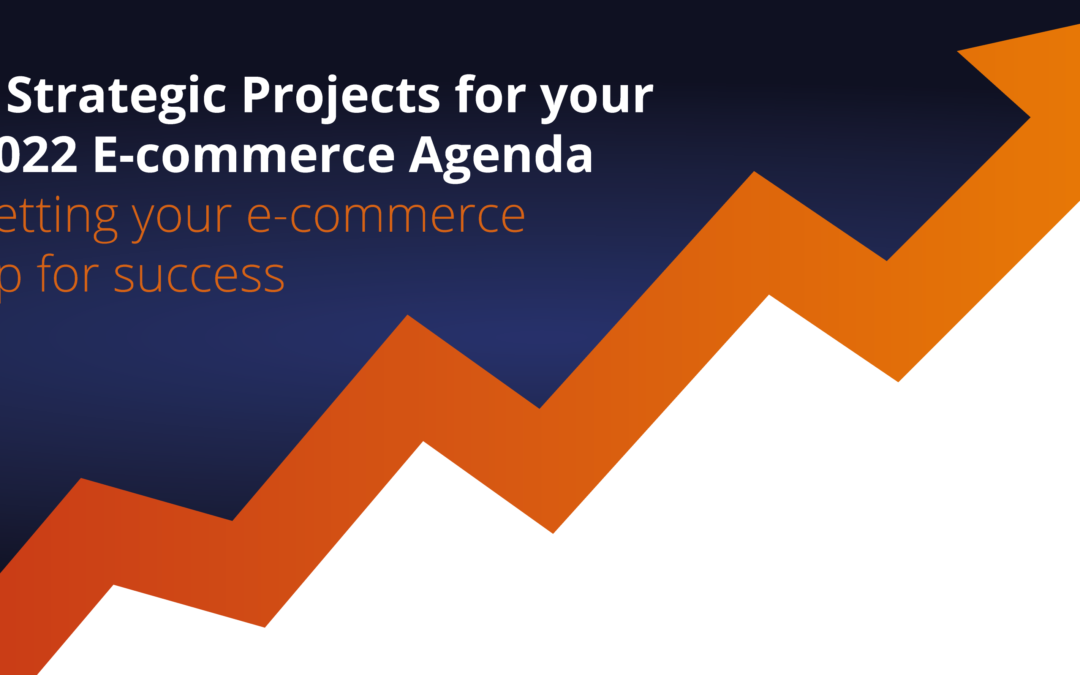
3 Strategic Projects for your 2022 E-commerce Agenda

The success of e-commerce in 2021 doesn’t mean that retailers can rest easy and rely on consistent growth. In 2022, favoured online shops will be those who re-engineer eCommerce strategies towards tech and behavioural focussed operations, investing in their digital offerings rather than seeing it as an unnecessary expense due to a successful previous year. Setting yourself up for success by focussing on milestone projects such as those set out in this article offers guidance. After deciding on milestone projects, retailers can begin looking at the company roadmap on a more granular level.
Let’s look at three robust strategies that should form the basis of 2022’s agenda.
- Create an Ecosystem of Tech Partners
Leveraging technology vendors to build an ecosystem is critical. With 83% of shoppers reporting a “mediocre” overall user experience, there is a window of opportunity to stand out that can only be achieved by supercharging existing operations, most commonly and easily done though third-party providers.
Best-of-breed platforms allow retailers to achieve a gold-standard CX, which they wouldn’t have otherwise had the time, money or resources to create or implement within niche areas. Preferably this should be done through APIs – decoupling the front and back end and having them talk to one another via APIs gives retailers more flexibility to create unique experiences for their visitors and eliminate boundaries. As part of a network, transferred information isn’t met with roadblocks and can instead seamlessly travel back and forth for superfast performance.
From onsite optimisations, to acquisition and supply chain management, both internal and customer facing operations can be improved for operational excellence.
Whether you already have a fully operational headless architecture, or are looking to develop one, there are critical areas that play an essential role in any e-commerce’s tech stack. The enormous pool of plugins and optimisations leave many organisations with a dilemma – which ones are essential and which are nice to have?
Moving forward, a headless architecture is clearly favourable and has assisted thousands of merchants in successfully scaling and delivering cutting-edge, and agile experiences, so researching where you need to deploy third party technologies and level up performance in 2022 should be on the corporate agenda.
- Think Omnichannel
When it comes to brand visibility, widening the net in which shoppers can discover your brand is critical and forming a robust omnichannel strategy in 2022 will be instrumental to success. Channels like product reviews or Instagram advertising are just the beginning and expanding coverage on a now more than ever, digitally mature society is a catalyst for growth.
Drilling into data and analysing how behaviours change should be the protocol when looking to deliver end-to-end digital experiences. Wherever your customers buy, expanding your reach to include not only your online store or social channels but also integrating channels such as fulfilment or management tools will help to create a flexible buying model. Harnessing technologies to help manage the complexities that come with an omnichannel strategy and look at the whole strategy more holistically is a consideration. This is particularly important when you consider that every touchpoint and channel must be connected and form a cohesive journey – this is the main distinction between an omnichannel strategy and a multichannel strategy.
While we consider onsite experience a requisite, this must be delivered across all channels for a consistently good experience throughout the customer journey.
To get the most out of omnichannel, retailers need to focus on the following:
- Existing valuable channels
- What their buyer journey looks like
- Personalising experiences
- Utilising all of their data
- Increasing brand awareness
Creating an omnichannel experience can help bridge the gaps between existing channels, as well as benefiting from new ones. But referring back to ‘Creating an Ecosystem of Partners’, it is important to recognise the power of third party tools when navigating more complex strategies.
- Identify and Prioritise your Pain Points
E-commerce is fast-paced and there seems to be endless optimisations promising to improve customer experience and boost revenue. Prioritising areas for improvement when looking to supercharge end-to-end activities is essential when looking for high-impact solutions.
A go to methodology that allows you to maximise on the decisions you make as an organisation should be pinned down for use throughout 2022. By assessing which areas are the most high-severity and impeding performance, there is more overall transparency about what value optimisations will drive.
While metrics such as pain point frequency may sit at the epicentre of analysis, they should not be taken at face value.
For example, perhaps your shoppers don’t receive relevant recommendations on your website and this affects every visitor – yes it is annoying but it doesn’t stop shoppers from discovering products. Meanwhile, 10% of your visitors experience a deadend when they misspell a search query and abort your website.
Instinctively, transformational leaders may look to prioritise the deployment of recommendations as it affects more people; however, the 10% who experienced a deadend incurred a higher consequence as the chance of conversion was lost.
Leaders can begin to shape prioritisation framework by:
- Defining users and customer journeys
- Deciding which metrics they want to measure
- Proposing a scoring system to measure pain points
- Measuring impact
- Comparing this against internal thresholds
Retailers can understand more about how to action each framework stage here.
There is no silver bullet when looking to prioritise business processes, their unique requirements or perceived pain points. That said, standardising a scoring system that can be applied across the organisation enables more informed decision making and higher returns on investment. And, when looking to justify activities to gain organisational buy-in, internal decision-makers can quantify the potential uplift thanks to a more streamlined and effective process.

Rachel is a Content Marketing Specialist, creating insightful materials on all things eCommerce, tech and Findologic that drive growth and awareness. Rachel has a wide understanding of the tech space, before joining Findologic, she produced content for global FinTech publications as well as working closely with industry leaders on a range of marketing initiatives.
